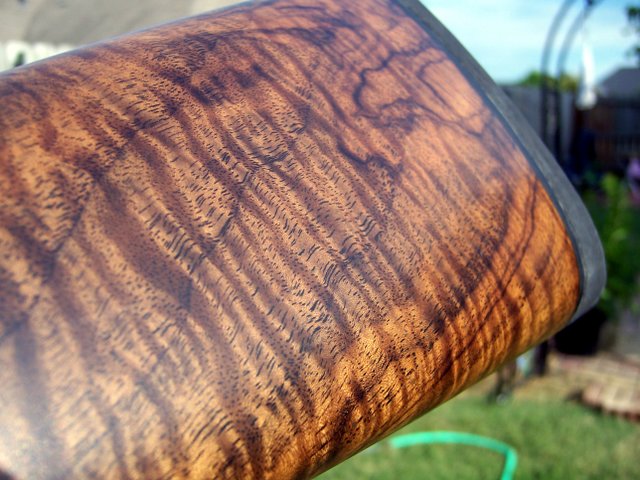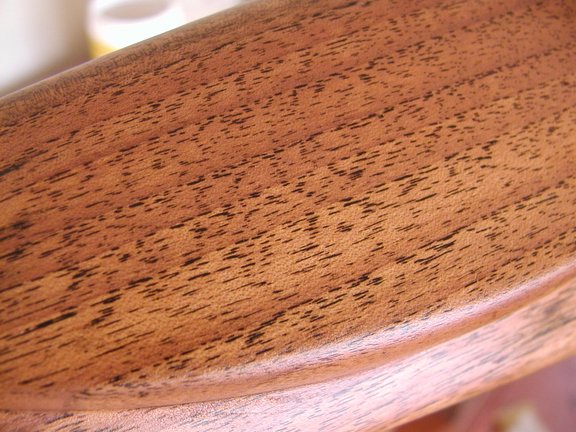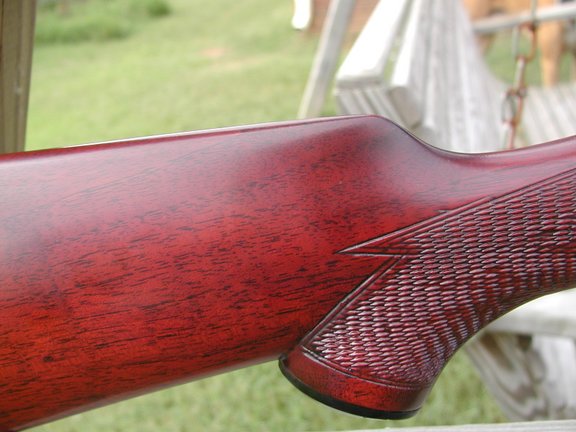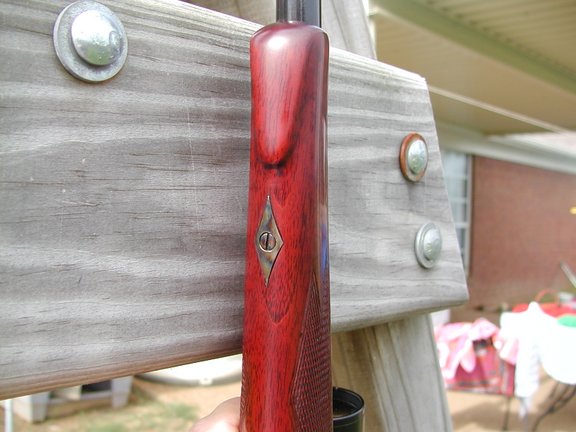

 The Accurate Reloading Forums
The Accurate Reloading Forums  THE ACCURATE RELOADING.COM FORUMS
THE ACCURATE RELOADING.COM FORUMS  Guns, Politics, Gunsmithing & Reloading
Guns, Politics, Gunsmithing & Reloading  Gunsmithing
Gunsmithing  Filling the grain.
Filling the grain.Go  | New  | Find  | Notify  | Tools  | Reply  |  |
One of Us |
I'm finishing a couple of rifle stocks and find it to be a labor intensive process. I am trying to fill the grain, so I put a coat of tru-oil on and then sand it off (400-600 grit). I have done this about six times and I'm wondering if there is a better way? ------------------------------------ Originally posted by BART185 I've had another member on this board post an aireal photograph of my neighborhood,post my wifes name,dig up old ads on GunsAmerica,call me out on everything that I posted. Hell,obmuteR told me to FIST MYSELF. But you are the biggest jackass that I've seen yet, on this board! -------------------------------------- -Ratboy | ||
|
one of us |
Leave the muck of dust and tru-oil on the stock untill the grain is filled. The last few times wipe with with a napkin. The last time wipe it all off. I like to thin tru-oil for this, it's too thick. ______________________ Always remember you're unique, just like everyone else. | |||
|
| One of Us |
With truoil I start wet sanding 50/50 mix with paint thinner using 320 grit. It makes much more slurry than the finer grits. Takes me 3 or 4 times. Wipe lightly across the grain with paper napkins not cloth or paper towels leaving a muddy blotchy finish. Let it dry over night each time. After it is filled sanding with 320 then progress to 400, 600 and more if you want. The last sanding with 320 and all coats after should be wiped completely off. Not just lightly smeared like when filling. Here's a truoil finish pic done this way.  | |||
|
| One of Us |
I do it like Dempsey does. I use a thinner polymer modified tung oil and wet sand with 320 and create a "mud coat" and let it dry on the stock for one week. Then I use 320 again to wet sand the mud coat off the surface just back to the wood, leaving the pores filled. Then I wet sand, again with the finish, with ever finer grits, wiping the stock with paper towels lightly after each sanding. There are fillers availabe that can speed the process. Birchwood Casey has one and you can also use spar varnish. After the varnish dries you can use a scraper to remove the excess just down to the wood surface. It does require a bit of practice so you don't mar the finish but it saves some time and fills the pores well. | |||
|
| One of Us |
I think "labor intensive" is the key phrase. Fine stock finishing is just that. You won't find that its happens quickly. | |||
|
| Moderator |
Chic and denpsey are spot on, of course. I like to use miniwax sanding sealer, these days.. instructions are right on the can... 2 costs seperated by an hour and a sanding, then go to lunch and sand, and then begin applying your final finish... really, its that easy. yep, its poly.. but give it a try and see.. just like spar varnish, but higher solids count. opinions vary band of bubbas and STC hunting Club Words aren't Murder - Political assassination is MURDER Information on Ammoguide about the416AR, 458AR, 470AR, 500AR What is an AR round? Case Drawings 416-458-470AR and 500AR. 476AR, http://www.weaponsmith.com | |||
|
| one of us |
I still do the above mentioned wetsanding techinque occasionally. Anymore though its a scraping method. Its much faster. Chic is correct though...takes practice or you can scratch your finish surface. If your game to try it get a set of scrapers from woodcraft and keepem sharp. A scraper burnisher works well for that. The sharper they are the less chance you will tend to bear down on them and then slip and make a mistake. If I have all the time I need to finish a stock, I will still wet sand with thinned varnish and do the mud coat process. If Im pressed for time - slather on the finish...and scrape it. | |||
|
| One of Us |
When yall are wet sanding, do you use a sanding block or your fingers? | |||
|
| one of us |
sanding blocks...... | |||
|
| One of Us |
I see little gain in sanding after every coat just to fill the pores in the wood. Besides, too much sanding can ruin a stock job. A trick taught to me by the great Kent Bowerly, is to thin your finish about 50-50 with mineral spirits and "Paint" it on. Keep doing it until the wood will not soak up any more finish and is built up on the surface until it is a glossy build-up. Let it set up a day or two between applications I then scrape it off, as Bill says, using a hack saw blade and other scrapers. Scrape it all off all the way down to the wood. This is a helluva lot quicker and essier than sanding between each coat.. I then wet sand using a mix of 25% mineral spirits and 75% finish and wipe it all off before it dries on the surface. Follow up with different sanding grits. Jim Kobe 10841 Oxborough Ave So Bloomington MN 55437 952.884.6031 Former Professional member American Custom Gunmakers Guild | |||
|
one of us |
The way I've done the last two stocks I've finished is "blacking out" the pours in the wood. I use 1 part bone black and 2 parts rotton stone and make a slurry with the finish I plan to use. It takes about 3 applications to get all the pours filled. To me it gives the grain a very distinctive look. On plain wood it's a life saver. They say the rotton stone is a little hard on checkering tools though. Here are a couple to give you an idea of what I'm talking about. Terry  Before the finish is applied  After   -------------------------------------------- Well, other than that Mrs. Lincoln, how was the play? | |||
|
| one of us |
TC1, Bone black is mentioned in the finishing section of Westbrook's book. Where did you find it? What is your technique to the 3 applications of the slurry mixture? Nice finish on the stocks. Brian | |||
|
one of us |
You can get it at Brownells and MidwayUSA. You simply mix the powders together and then pour in a little finish and made a thick mud. Take a piece of cloth and dab it in the mud and start rubbing it into the pours. After it dries (a day or so) wet sand the stock with 320 grit to get the excess filler off. repeat as necesary until all the pours are filled. Terry -------------------------------------------- Well, other than that Mrs. Lincoln, how was the play? | |||
|
| one of us |
Terry, What'd you use to get the red color on the second rifle? Thanks, John | |||
|
one of us |
Printers ink Terry Before  After  -------------------------------------------- Well, other than that Mrs. Lincoln, how was the play? | |||
|
| One of Us |
Gee I'm wondering who much I can get for a gram of Ebony dust :-) rich | |||
|
| One of Us |
The first few years I made stocks, I used mostly TruOil. In 1962 I switched to G-B Linspeed and never switched back. For more color I used mainly a very, very, little bit of alkanet root from Brownells. 1/4 teaspoonful of alkanet should be enough for about 200-300 or more stocks, I'd guess. (That's maybe a little tongue-in-cheek, but surely not very much so.) For fillers and sanding sealers, I used mainly the ones also sold by Brownell's and found they worked very well. The reason I preferred G-B Linspeed to Tru-Oil is that it in my hands it did less to obscure the true colours and contrasts of the wood grain. I did both thin it, and rub it in enough, to actually give a warmth to it and I used VERY little per coat, so it usually took me from 8-12 coats to get what I really wanted, which was a piece of wood that looked like polished marble or polished petrified wood, without the gloss. Usually took me about three weeks to do a single stock, at least one week of which was 40-60 hours of sanding and at least two weeks of letting finish coats dry. After the next to last coat I used pumice instead of paper, and after the last coat, rottenstone. Then came the wax. Everyone has their own way, so am not suggesting anyone use mine, just saying that it ain't just whistlin' Dixie to say it is labour intensive........ My country gal's just a moonshiner's daughter, but I love her still. | |||
|
| One of Us |
Beautiful, Terry! Rusty We Band of Brothers! DRSS, NRA & SCI Life Member "I am rejoiced at my fate. Do not be uneasy about me, for I am with my friends." ----- David Crockett in his last letter (to his children), January 9th, 1836 "I will never forsake Texas and her cause. I am her son." ----- Jose Antonio Navarro, from Mexican Prison in 1841 "for I have sworn upon the altar of god eternal hostility against every form of tyranny over the mind of man." Thomas Jefferson Declaration of Arbroath April 6, 1320-“. . .It is not for glory, nor riches, nor honours that we are fighting, but for freedom - for that alone, which no honest man gives up but with life itself.” | |||
|
| Powered by Social Strata |
| Please Wait. Your request is being processed... |
|

Visit our on-line store for AR Memorabilia

